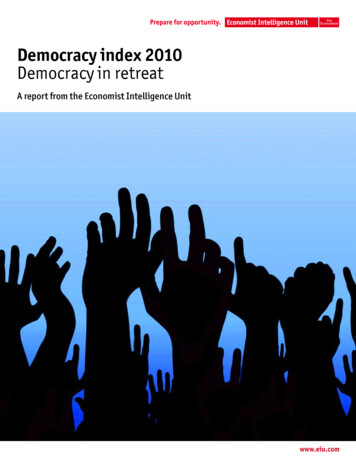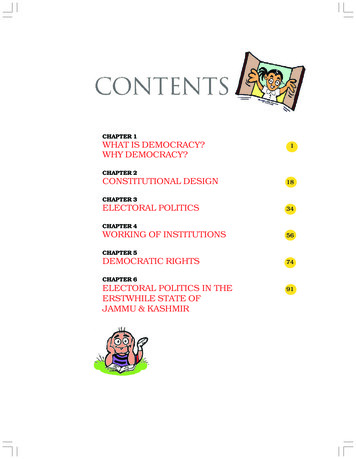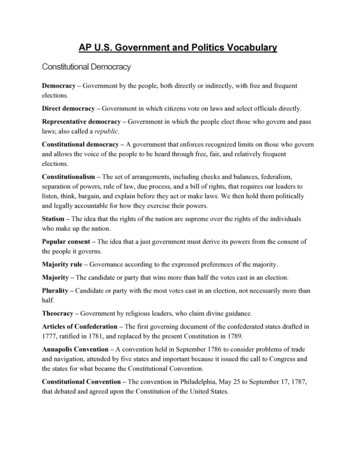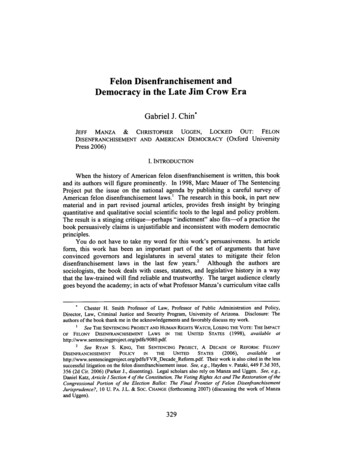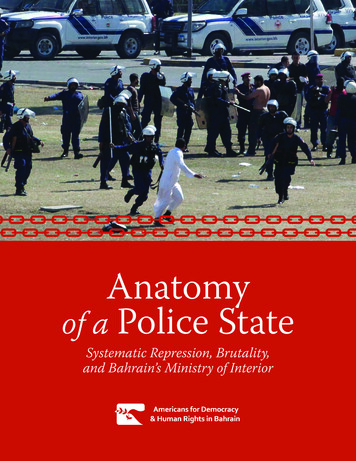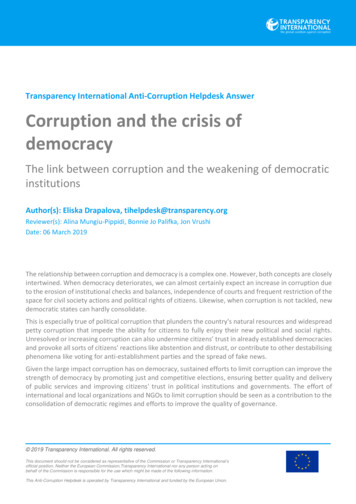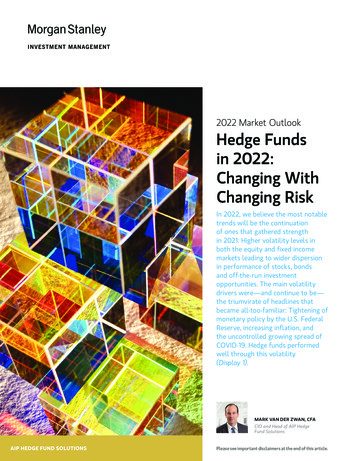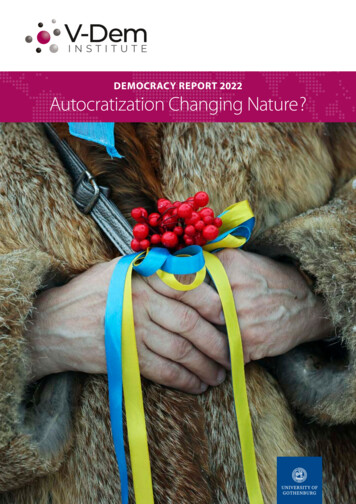
Transcription
DEMOCRACY REPORT 2022Autocratization Changing Nature ?
V-Dem is a unique approach tomeasuring democracy – historical,multidimensional, nuanced,and disaggregated – employingstate-of-the-art methodology.Varieties of Democracy (V-Dem) produces the largest global dataset on democracywith over 30 million data points for 202 countries from 1789 to 2021. Involving over3,700 scholars and other country experts, V-Dem measures hundreds of differentattributes of democracy. V-Dem enables new ways to study the nature, causes, andconsequences of democracy embracing its multiple meanings.We are very grateful for our funders’ support over the years, which has made this venture possible.To learn more about our funders, please visit: https://v-dem.net/funders.html.The views and opinions expressed in this report are those of the authors and do not necessarilyreflect an official position of the V-Dem Project or the V-Dem Steering Committee.Produced by the V-Dem Instituteat the University of GothenburgDemocracy Report Team: Nazifa Alizada, Vanessa A. Boese,Martin Lundstedt, Kelly Morrison, Natalia Natsika, Yuko Sato,Hugo Tai, and Staffan I. Lindberg.V-Dem Data and Management Team: Nazifa Alizada,Lisa Gastaldi, Sandra Grahn, Garry Hindle, Nina Ilchenko,Natalia Natsika, Josefine Pernes, and Johannes von Römer.Cover photo: Rally at Sophia Square in Kyiv, Ukraine, January 22,2022, as Russian military invasion seems possible. Photo by SeanGallup, Getty Images.Suggested citation: Vanessa A. Boese, Nazifa Alizada, MartinLundstedt, Kelly Morrison, Natalia Natsika, Yuko Sato, Hugo Tai,and Staffan I. Lindberg. 2022. Autocratization Changing Nature?Democracy Report 2022. Varieties of Democracy ditors: Vanessa A. Boese and Staffan I. Lindberg.Design and Final Art: Harald Schörnig, Frank & Earnest.Printing: Stema Specialtryck AB.V-Dem Institute:Department of Political ScienceUniversity of GothenburgSprängkullsgatan 19, P.O. box 711SE-405 30 Gothenburg Swedencontact@v-dem.net 46 (0)31 786 30 43www.v-dem.netMarch 2022Copyright 2022 by V-Dem Institute. All rights reserved.Follow us on social minstitute
DEMOCRACY REPORT 2022Table of ContentsWord from the Team 5Executive Summary 6State of the World:Autocratization Changing Nature? 9Democracy Worldwide in 2021 12Democratizers and Autocratizers 18Autocratization Changing Nature? 30The Case for Democracy 38V-Dem in Numbers 44V-Dem Methodology 48V-Dem Indices 50Publications from the V-Dem Team 573
4DEMOCRACY REPORT 2022İstanbul Turkey, March 27, 2021. LGBTİ andwomen protested the withdrawal of Turkey'sIstanbul Convention. Photo: Shutterstock.
DEMOCRACY REPORT 2022Word from the TeamWE ARE PLEASED TO PRESENT the Democracy Report2022 from the V-Dem Institute. Our report comesduring challenging times as the world is facing a war in Europe,rising tensions in the East Asia-Pacific region, a return of militaryand other coups, and new heights of polarization across manysocieties. It is our hope that the Democracy Report 2022 will contribute to a greater understanding of the global challenges todemocracy.Like many other observers around the world, we are deeplyconcerned with the decline of democracy over the past decade.This year’s Democracy Report documents a continuation of thattrend during 2021. This intensifying wave of autocratizationaround the world highlights the need for new initiatives to defenddemocracy. In 2021, a series of such engagements originated fromthe highest levels as well as a by a multitude of important grassroots actions around the world.But engagement to protect and promote democracy must buildon science to be effective. Facts must meet misconceptions andlies about the virtues and limitations of democratic and autocraticgovernance.That is why we started the Case for Democracy with financialsupport from the European Union. It collates state-of-the-artresearch on the dividends of democracy for economic andhuman development, health and socio-economic protections,environmental protection and climate change mitigation, as wellas for international and domestic security. You will find a specialbox with summary of findings in this year’s Democracy Report.We look forward to carrying on and expanding these efforts inthe coming years.The Democracy Report 2022 presents findings based on the newestedition of the V-Dem dataset (version 12). The data is the resultof a vast international collaboration. We are immensely gratefulto the 3,700 country experts without whose contribution V-Demwould not be possible, and to the Country Coordinators, RegionalManagers, Project Managers, and Steering Committee Membersfor their principal roles.Finally, this is the first Democracy Report produced withoutAnna Lührmann. She joined the Institute as a postdoc in 2015,then became Assistant Professor and Deputy Director. Annafounded the Democracy Report and led the work during hertenure. We miss her presence deeply, but we congratulateGermany to have Anna as Minister of State for Europe. Anna, wehope you read this report and feel proud of your legacy.Staffan I. LindbergVanessa A. BoeseJosefine PernesGarry HindleNazifa AlizadaNatalia NatsikaLisa GastaldiJohannes von RömerNina IlchenkoSandra GrahnMartin LundstedtKelly MorrisonYuko SatoAmanda EdgellJuraj MedzihorskyMatthew WilsonJean LachapelleSebastian HellmeierTaiwo Ayodeji AhmedAdea GafuriBerker KavasogluValeriya MechkovaOskar RydénMelina LiethmannAaron MannisHugo TaiThe V-Dem Institute Team5
6DEMOCRACY REPORT 2022Executive SummaryDEMOCRACY WORLDWIDEIN 2021TOXIC POLARIZATIONWORSENING2021 The level of democracy enjoyed by the average globalcitizen in 2021 is down to 1989 levels. The last 30 yearsof democratic advances are now eradicated. Dictatorships are on the rise and harbor 70% of theworld population – 5.4 billion people. There are signals that the nature of autocratizationis changing.Back to 1989 Levels Liberal democracies peaked in 2012 with 42 countriesand are now down to the lowest levels in over 25 years– 34 nations home to only 13% of the world population. The democratic decline is especially evident in AsiaPacific, Eastern Europe and Central Asia, as well as inparts of Latin America and the Caribbean.Dictatorships on the Rise The increasing number of closed autocracies – up from25 to 30 countries with 26% of the world population –contributes to the changing nature of autocratization. Electoral autocracy remains the most common regimetype and harbors 44% of the world’s population,or 3.4 billion people.Ten Years Ago – A Different World A record of 35 countries suffered significantdeteriorations in freedom of expression at the handsof governments – an increase from only 5 countries10 years ago. A signal of toxic polarization, respect for counter arguments and associated aspects of the deliberativecomponent of democracy got worse in more than32 countries – another increase from only 5 nationsin 2011.201132 countries5 countriesNUMBER OF COUNTRIESTHREATENING FREEDOMOF EXPRESSION20112021355SHARE OF WORLD POPULATIONLIVING IN AUTOCRACIES2021201170%49%
DEMOCRACY REPORT 2022DEMOCRATIZERS ANDAUTOCRATIZERSAUTOCRATIZATIONCHANGING NATURE ? 2021 comes with a record number of nations autoc ratiz ing in the last 50 years – 33 countries home to 36% of theworld population – 2.8 billion people. The “epidemic of coup d’états” in 2021 suggests thatbolder actions of autocratization are becoming morecommon. The EU may be facing its own wave of autocratization –20% of members are autocratizing. Polarization escalates towards toxic levels in40 countries.A Record 33 Countries are Autocratizing Autocratic governments increasingly use misinformationto shape domestic and international opinion in theirfavor. Democracy broke down in 7 of the top 10autocratizing countries over the last decade. The world has not recorded so few democratizerssince 1978 – 15 countries in 2021, with 3% of theworld population.Democratization Across Regions Across regions, elections are the aspect of democracywith the highest average improvement amongdemocratizers. In Latin America and the Caribbean, democratizingcountries made the greatest improvements in judicialconstraints on the executive – making leaders moreaccountable than a decade ago.Autocratization Across Regions Repression of civil society worsened in 22 andcensorship of media in 21 of the 33 autocratizingcountries. Leaders in autocratizing countries diminished respectfor counterarguments in 19 countries – a signal of thechanging nature of autocratization.A Year of Coups The 5 military and 1 self-coup in 2021 set a recordfor the 21st century in a sharp break from the averageof 1.2 coups per year. The coups resulted in 4 new closed autocracies –Chad, Guinea, Mali, and Myanmar.A Wave of Polarization Signaling a changing nature of autocratization,polarization is increasing to toxic levels in 40 countries. Toxic levels of polarization contribute to electoralvictories of anti-pluralist leaders and theempowerment of their autocratic agendas.Misinformation Multiplying Governments increasingly use misinformation toshape domestic and international opinion. MENA is the region with the highest – and mostincreasing – levels of government misinformation.The Major Democratizers Among the top 10 democratizing countries, 6 transitioned from autocracy and are democracies in 2021. But few of the democratizers continue to improvefurther.The Major Autocratizers Anti-pluralist parties drive autocratization in at least6 of the top 10 autocratizers – Brazil, Hungary, India,Poland, Serbia, and Turkey 6 out of 27 EU member states are now autocratizing.Three EU neighbors to the east are also autocratizing.SHARE OF WORLD POPULATIONLIVING IN AUTOCRATIZINGCOUNTRIESPopular Mobilization in (Another) YearofAutocratization Popular mobilization continues to stay at low levels.This lack of a pro-democratic mobilization risksallowing autocratization to deepen unchallenged. Rising levels of pro-autocracy mobilization may signalthat autocratizing leaders are taking bolder actionsto demonstrate legitimacy.20115%202136%7
8DEMOCRACY REPORT 2022Stop Killing Afghan Protest in London, August 2021.Photo: Ehimetalor Akhere Unuabona, Unsplash
DEMOCRACY REPORT 2022State of the World:Autocratization Changing Nature?AWAR BEGAN IN EUROPE. This war is the doing of the same leader who triggered the thirdwave of autocratization1 when he began to derail democracy in Russia 20 years ago. The invasionseems like a definite confirmation of the dangers the world faces as a consequence of autocratizationaround the world.On the day we finalize this year’s Democracy Report, President Putin ordered a full-scale invasion of Ukraine,an independent country led by an elected government. For years, scholars warned that the global waveof autocratization would lead to more wars, both inter-state and civil (see also box on the Case forDemocracy at the end of this report). The Democracy Report 2022 also points to this shift in the nature ofautocratization. Various pieces of evidence point to leaders becoming bolder and taking more drastic actions, leading to further autocratization.This Democracy Report documents several signs that autocratization is changing nature. With five militarycoups and one self-coup, 2021 featured an increase in coups unprecedented over the past two decades.These coups contributed to driving the uptick in the number of closed autocracies. They also seem tosignal a shift toward emboldened actors, given the previous decline in coups during the 21st century. Polarization and government misinformation are also increasing. These trends are interconnected.Polarized publics are more likely to demonize political opponents and distrust information from diversesources, and mobilization shifts as a result. The increase in misinformation and polarization further signalswhat may prove to be a changing nature of autocratization in the world today. We discuss this shift indetail in the third part of the report: “Autocratization Changing Nature?”.Another sign of emboldened political leaders is the increasing number of countries where critical, formalaspects of democracy are eroding. The autonomy of institutions such as Election Management Bodies(EMBs) are now attacked and undermined in many autocratzing countries alongside the judiciary and thelegislature. This year’s Democracy Report documents such changes.The Democracy Report 2022 is published along with version 12 of the V-Dem dataset.2 The dataset is produced by the worldwide V-Dem collaboration and is based on assessments by over 3,700 experts frommore than 180 countries, resulting in over 30 million data points. The Democracy Report 2022 is authoredby a team at the V-Dem Institute, and we alone are accountable for its contents.The Democracy Report 2022 analyzes the evidence from three perspectives. The first part examinesthe state of the world in 2021 based on the Liberal Democracy Index (LDI) and the Regimes of theWorld (RoW) Index. The second part of the report focuses on countries that are in a process of c hanging.The third part presents data on coups, polarization, and disinformation, all of which signal that the fundamental dynamics of the current wave of autocratization may be changing.In summary: The worldwide wave of autocratization is deepening, engulfing more countries, and seemsto be changing nature.1 Lührmann A. and Lindberg S.I. 2019. A Third Wave of Autocratization Is Here. Democratization 26(7).2 The V-Dem Project improves the quality of the released data every year by engaging additional, specialized country experts and further refining themethodology. This process of constant improvement may lead to a correction of scores reported in earlier versions of the dataset and the Democracy Report.9
DEMOCRACY REPORT 2022FIGURE 1: COUNTRIES BY SCORE ON V-DEM’S LIBERAL DEMOCRACY INDEX (LDI), 2011 COMPARED TO 2021Top 50% of countriesTop 10%20112021Top 10 20%Autocratizing countriesDemocratizing countriesUnited iaLithuaniaJapanUnited States of AmericaLatviaCzech RepublicTaiwanJamaicaCyprusBarbadosGreeceTop 20 30%ScoreConfidence intervalSwedenDenmarkNorwayCosta RicaNew th KoreaSpainVanuatuArgentinaTrinidad and TobagoPeruIsraelCape th AfricaSao Tome and PrincipeSeychellesGhanaPanamaArmeniaTop 30 40%Figure 1 shows every country’s ratingon the LDI in 2021 in rank order, as wellas the change over the last 10 years.Country names highlighted in bluehighlight the 15 countries with significantdemocratization and red country namesreveal which 33 countries have undergonesubstantial autocratization. Countries arealso divided into groups from the top 10 to50% to the bottom 50 to 10%.Score and Confidence MongoliaGeorgiaTimor LesteBotswanaBhutanBurkina FasoSolomon IslandsDominican RepublicColombiaEcuadorNepalMauritiusTop 40 50%10LiberiaTunisiaMaldivesIndonesiaParaguaySierra LeoneKosovoPolandThe GambiaAlbaniaKenyaNigerNorth MacedoniaMontenegroMexicoSri LankaBoliviaGuyana0.000.2520210.50Liberal Democracy Index2011Democratizing0.75Autocratizing1.00
STATE OF THE WORLDScore and Confidence IntervalsBottom 40 50%Bottom 30 40%20112021Bottom 20 30%Autocratizing countriesDemocratizing rMozambiqueIvory CoastMoroccoHondurasPakistanIraqEl SalvadorUgandaHaitiGabonHong iaCentral African RepublicDemocratic Republic of CongoEthiopiaLibyaAlgeriaPalestine/West tiBottom 10 20%ScoreConfidence intervalHungaryGuinea BissauIndiaBosnia and HerzegovinaNigeriaPapua New gladeshTurkeyGuineaEswatiniRepublic of the nited Arab EmiratesCubaBurundiVenezuelaBottom 10%Bottom 50% of countriesAzerbaijanChadCambodiaPalestine/GazaSouth SudanNicaraguaEquatorial GuineaBahrainTajikistanSaudi nNorth KoreaEritrea0.000.2520210.50Liberal Democracy Index2011Democratizing0.75Autocratizing1.0011
12DEMOCRACY REPORT 2022Democracy Worldwide in 2021Western Europe, North America, and parts of Latin America,Oceania, and East Asia remain among the most democraticregions of the world. The least democratic areas in the worldinclude the Middle East and North Africa (MENA) region,Central Asia, and parts of Sub-Saharan Africa. Countries such asAfghanistan, Belarus, China, Russia, Saudi Arabia, Sudan, and Venezuela are among the most autocratic in the world. The mapin Figure 2 shows this state of democracy in 2021 based on theLiberal Democracy Index (LDI).3 The level of democracy enjoyed by the averageglobal citizen in 2021 is down to 1989 levels – the last30 years of democratic advances are now eradicated. The number of liberal democracies is down to 34in 2021. There have not been so few since 1995 –over 26 years ago. Closed autocracies are up from 25 to 30 between2020–2021. Electoral autocracy remains the mostcommon regime type in the world – 60 countries.Together, autocracies now harbor 70% of the worldpopulation – 5.4 billion people.Back to 1989 Levels The level of democracy enjoyed by the average globalcitizen in 2021 is down to levels last registered in 1989.The last 30 years of democratic advances following theend of the Cold War have been eradicated. A record 35 states suffer from significantdeteriorations in freedom of expression at the handsof governments – ten years ago it was only 5. The decline is especially evident in Asia-Pacific, EasternEurope and Central Asia, as well as in Latin America andthe Caribbean. Signaling “toxic polarization”, the deliberativeaspects worsened substantially in 32 countries –another massive increase from the count of 5ten years ago.The level of democracy enjoyed by the average global citizen in2021 is down to a low point not registered since 1989 (Figure 3,red line). From this perspective, the last ten years set the worldback 32 years. The far-reaching expansion of rights and freedomsaround the world over that period has been eradicated. Autonomy of electoral management bodies (EMB)was blatantly undermined by governments in25 countries over the past ten years.Since democracy is rule by the people it matters how many peopleare enjoying democratic rights and freedoms around the world.FIGURE 2: STATE OF LIBERAL DEMOCRACY IN 202100.10.20.30.40.50.60.70.80.913 V-Dem’s Liberal Democracy Index (LDI) captures both electoral and liberal aspects of democracy and goes from the lowest (0) to the highest (1) levels of democracy. The electoralcomponent is measured by the Electoral Democracy Index (EDI) that captures the extent to which all elements of Robert Dahl’s (1971) famous articulation of “polyarchy” are present,including the quality of elections, individual rights, as well as the media and freedoms of association. The Liberal Component Index (LCI) captures the liberal aspects including checksand balances on the executive arm of government, respect for civil liberties, the rule of law, and the independence of the legislature and the judiciary. Dahl, R.A. 1971.Polyarchy: participation and opposition. New Haven: Yale University Press.
STATE OF THE WORLDThe population-weighted measure is arguably therefore a moremeaningful measure of the state of democracy worldwide.The decline by population-weighted measures is especiallyevident in Asia-Pacific, Eastern Europe and Central Asia, as wellas in Latin America and the Caribbean, even if the latter remainsone of the more democratic regions. In Asia-Pacific, the degreeof liberal democracy enjoyed by citizens is down to levels lastseen in 1986, some 35 years ago. Average democracy in EasternEurope and Central Asia has gradually regressed down to a levelfound in 1991 at the end of the Cold War. Similarly, democracy inLatin America and the Caribbean has now fallen to an averagelevel last seen in the region around 1990.Figure 3 captures the rise in democracy around the world,showing the “third wave of democratization” starting in 1974and peaking after the end of the Cold War. A worldwide steepdecline in liberal democracy started around 2011 (right-handpanel). The dramatic decline for people over the past decadeis masked when only country-averages are counted, as in theleft-hand panel. The red line in that panel shows that by straightcountry-averages, democracy has reverted only to the 2000-level.0.90.90.80.80.70.70.60.6Average Weighted ValueAverage ValueFIGURE 3: LIBERAL DEMOCRACY INDEX, GLOBAL AND REGIONAL AVERAGES 1971–20210.50.40.3World0.5Eastern Europe and Central AsiaSub Saharan AfricaThe Middle East and North Africa0.30.20.10.11971Latin America and the Caribbean0.40.20.0Asia and the PacificWestern Europe and North 2021Figure 3 compares the state of the world in 2021 to global and regional trends since 1971. The black lines represent global averages on the LDI with the grey area marking theconfidence intervals. The left panel is based on conventional country averages. The right-hand panel instead shows average levels of democracy weighted by population.DemocracySince the ancient Greeks first gave us the term δημοκρατία, themeaning of “democracy” has evolved considerably. V-Dem seeks toreflect the contemporary varieties of democracy, each encompassingmany different attributes. We measure over 450 aspects in the mainV-Dem Dataset, and several more in additional datasets associatedwith V-Dem such as the V-Party and the Episodes of Regime Transformation Dataset. They jointly inform us about the state of politicalinstitutions and rights worldwide.The V-Dem Institute’s Democracy Report sheds light on the state ofdemocracy worldwide without losing the eye for key details. Withoutintent to underrate other varieties of democracy, the report focuseson the Liberal Democracy Index (LDI) that combines the electoral“core” institutions with the liberal aspects – executive constraintby the legislature and high courts, and rule of law and individualrights. This measure is among the most sophisticated measures thatV-Dem offers.The Regimes of the World measure is a categorical measure classifying countries into four distinct regimes: the two forms of democracy(electoral and liberal) and two types of autocracies (electoral andclosed). To be considered minimally democratic, i.e. an electoraldemocracy, a country has to meet sufficiently high levels of free andfair elections as well as universal suffrage, freedom of expressionand association. Hence, solely holding elections does not suffice fora country to be considered democratic. Countries in which liberalaspects (executive constraint by the legislature and high courts, rule oflaw and individual rights) are respected on top of the requirements forelectoral democracy, are considered liberal democracies. In electoralautocracies, there are institutions emulating democracy but fallingsubstantially below the threshold for democracy in terms of authenticity or quality. In closed autocracies, an individual or group of peopleexercise power largely unconstrained by the people.The Democracy Report should serve as an entryway to examine thenumerous varieties of democratic attributes available in the V-Demdataset. Categorizing regimes with the Regimes of the World indexinherently reduces the nuance available in the universe of V-Demindicators. Visit the website and explore the data, for example usingonline graphing tools: https://v-dem.net.13
DEMOCRACY REPORT 2022Dictatorships on the RiseThe number of liberal democracies continues to dwindle fromthe peak at 42 in 2012 down to 34 countries now. Not since 1995has the world harbored so few liberal democracies. The share ofthe world population living in liberal democracies also declinedin the last decade. Only 13% lived in the least populous regimetype at present: liberal democracies. Liberal democracies peaked in 2012 with 42 countries.There are only 34 in 2021. There have not been so fewliberal democracies in the world since 1995 – over 25years ago. Only 13% of the world's population live in thisleast populous regime type.In Sub-Saharan Africa, there are only two liberal democracies:Botswana and Seychelles. Likewise, there are only two liberaldemocracies in Eastern Europe and Central Asia: Estonia andLatvia. Because of their small populations, these countries barelyregister in Figure 5, which tracks the population share living ineach regime type across regions. Dictatorships are on the rise – up from 25 to 30 closedautocracies between 2020 and 2021. This developmentadds to the picture of a change in the nature ofautocratization. Electoral autocracies is the most common regime typeand harbor the largest share of the world population –44% or 3.4 billion people.Electoral democracies have increased substantially in numbersince the end of the 1980s. It remains the second common regimetype, amounting to 55 countries in 2021. However, the share ofthe world’s population living in electoral democracies decreasedmarkedly in recent years. A mere 16% of the world’s populationlive in these 55 countries by 2021.Most of the analyses in Democracy Report 2022 focus on gradualchanges in the LDI, which is an original index from V-Dem andone of its most nuanced products. This section uses the Regimesof the World (RoW) categorization of four distinct regime types(closed autocracies, electoral autocracies, electoral democracies,and liberal democracies,4 see Figure 4). This categorization allowsfor a more compact analysis capturing some additional aspectsof the broad global trends.Two countries – Armenia and Bolivia – made democratic transitions from electoral autocracy to electoral democracy in 2021. Butfour countries were also downgraded over the last year from liberaldemocracy to electoral democracy: Austria, Ghana, Portugal,and Trinidad and Tobago. For Austria, a significant decline onthe indicator for transparent laws and predictable enforcementis a decisive change that contributed to Austria falling below thecriteria for liberal democracy. The reclassification of Ghana is alargely consequence of falling below the RoW threshold for liberaldemocracy on the level of access to justice for both men andwomen. Similarly, Trinidad and Tobago’s transparent laws andBy the Regimes of the World classification, there were 89 democracies and 90 autocracies in the world in 2021.5 However, autocraticcountries are far more populous. In 2021, 70% of the world population – 5.4 billion people – live in closed or electoral autocracies.A mere 13% of the world’s population reside in liberal democracies, and 16% in electoral democracies.FIGURE 4: NUMBER OF COUNTRIES AND SHARE OF POPULATION, BY REGIME TYPE 1971-2021100556660606055504240343530Share of World Population (%)7020444580305250 5190 87Number of Countries1435Closed Autocracy302625Electoral AutocracyElectoral DemocracyLiberal Democracy20 021197119811991200120112021Figure 4 plots the number of countries (left-hand panel) and the share of the world’s population (right-hand panel), by regime type.4 The typology and indicator are published in Lührmann et al. 2018. Regimes of the World (RoW). Politics and Governance 6(1). It builds on V-Dem data as well as the liberal and electoraldemocracy indices but is not officially endorsed by the V-Dem Steering Committee and international team.5 Naturally, uncertainty remains about regimes that exhibit similar degrees of authoritarian and democratic traits and thus are close to the threshold between democracy and autocracy.In 2021, such uncertainty applied to 20 countries. Thus, the number of autocracies in the world might range from 80 to 100 countries, with 90 being our best estimate. For more details,refer to the variable v2x regime amb in the V-Dem dataset, v12.
STATE OF THE WORLDpredictable enforcement, as well as access to justice for women,have declined and fallen below the RoW thresholds for qualifyingas a liberal democracy. Portugal’s score on access to justice forwomen declined but is only just below the threshold that theRoW methodology stipulates. Ghana, Portugal, and Trinidadand Tobago are all classified in the electoral democracy “upperbound”, indicating that their classification by the RoW methodology is somewhat uncertain with Portugal sitting on the fence.The downgrading of these countries, in particular Portugal,should therefore be interpreted with caution.Electoral autocracies6 are home to the largest share of the worldpopulation following India’s downgrade to electoral democracy in 2020. In 2021, 44% of the world’s population – 3.4 billionpeople – live in electoral autocracies. Very large proportions of theworld population live in electoral autocracies in Eastern Europeand Central Asia, Africa, and Middle East and North Africa (Figure5). In 2021, countries such as El Salvador, Nigeria, and Tunisiaturned into electoral autocracies and there are now 60 electoralautocracies, making it the most common regime type.Notably, closed autocracies are on the rise. This is a new development in the “third wave of autocratization” that is more pronounced in 2021 than in previous years. The number of dictatorships has been dwindling since the 1970s. From a record low of 20closed autocracies in 2012, there were 30 in 2021. In the last yearalone, five countries reverted to closed autocracy.This increase is one of the signals of the changing nature of autocratization that we discuss further below.
Table of Contents Word from the Team 5 Executive Summary 6 State of the World: Autocratization Changing Nature? 9 Democracy Worldwide in 2021 12 Democratizers and Autocratizers 18 Autocratization Changing Nature? 30 The Case for Democracy 38 V-Dem in Numbers 44 V-Dem Methodology 48 V-Dem Indices 50 Publications from the V-Dem Team 57 DEMOCRACY REPORT 2022 3
